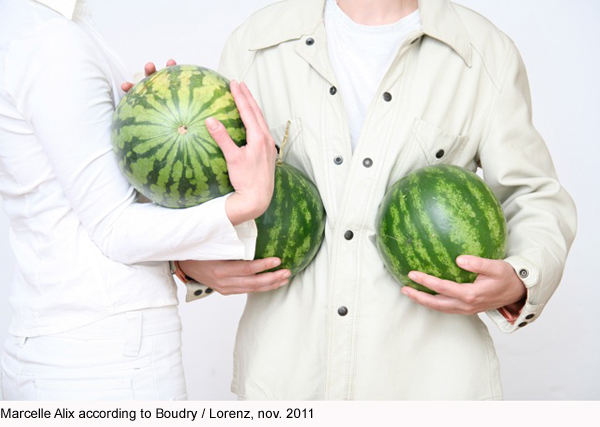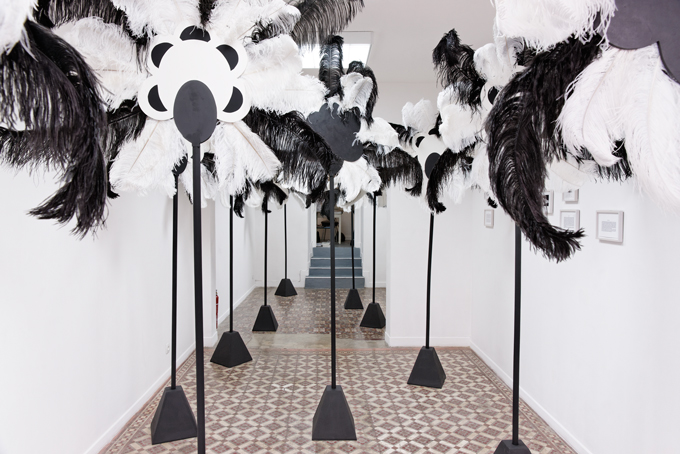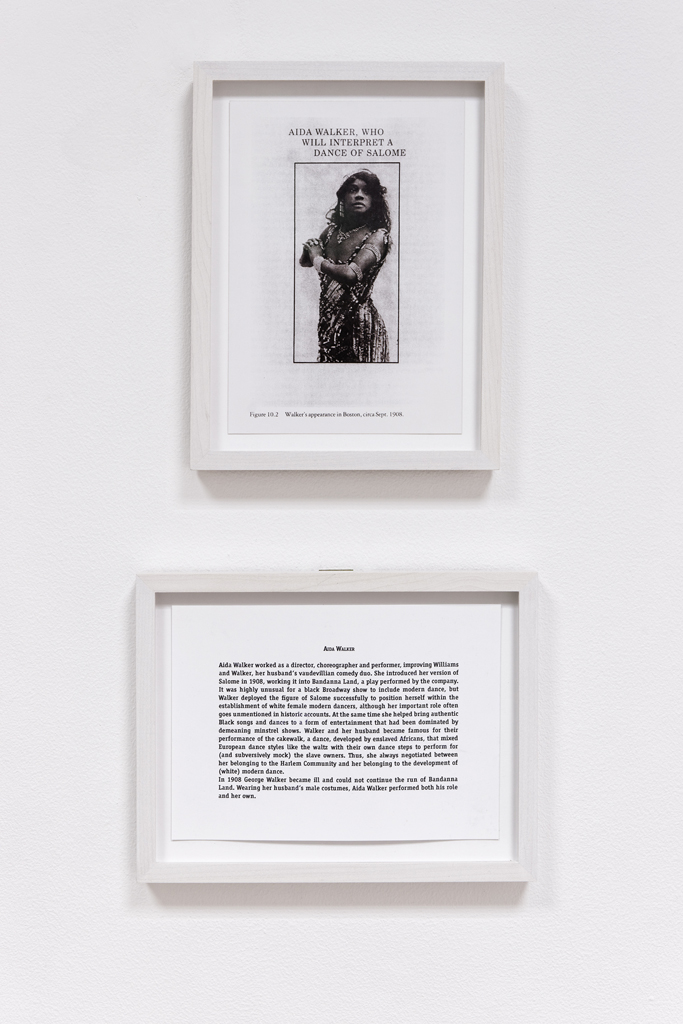
Salomania
Pauline Boudry / Renate Lorenz
12.11.2011 - 28.01.2012, vernissage 12.11.2011

[En français plus bas]
Pauline Boudry and Renate Lorenz stride along in libraries, spend time in archives, such as the ones of Magnus Hirschfeld, a sexologist and supporter of homosexuals? rights, or those of Arthur Munby, a British bourgeois, which retell the story of his sado-masochist relationship with a maid. Their films and installations reconstruct several objects of the past by overlaying different temporalities. They decipher and interpret a history of images that underlines social relations and class differences at play. Their method consists in giving back value to minority positions and their subversive power, by shattering a normalised, hetero-centered interpretation, which had turned the transvestite and the trans-genre into freaks.
Like historians, the duo of artists builds intellectual bridges. Going from one image to the next, they make a cultural history of sexual categories accessible. N.O. Body (2008), Contagious (2010) or Normal Work (2007),which was presented at the gallery last January, all develop an in-depth analysis of the relationship between bodies and genres, starting with individual stories, which History had turned into mere anecdotes: from Annie Jones who worked as a "bearded lady", to the epileptic dancer, via Hannah Cullwick, the Victorian maid, proud of her muscles and of her working hands. Their installations often present the same structure: framed documents and a film that includes long sequences of performance.
The Dionysian impulse which the historical material under consideration betrays (representations of marginalised, perverted, pathologised, racialised or stigmatised bodies) is embodied by the gestures of performers and artists like Yvonne Rainer and Werner Hirsch, both filmed by Boudry/Lorenz. These drag performances read as updated versions of the archive, the contemporary images adding to the historical ones, multiple meanings and references to visual arts and alternative music scenes. Historical sources and filmed images seem to overlap. The performer borrows the clothing, behaviour, poses and gestures from the historical figure under study. The staging rehabilitates the position of the beholder: as he/she comes to understand the construction behind these images and the power relations at stake, he/she has no choice but to leave the voyeuristic position which Art History usually assigns to him/her.
Salomania (2009), the object of this exhibition, simultaneously explores the queer potential of the character of Salomé and the practice of drag performance. The video presents a drag show in which Wu Ingrid Tsang re-interprets the Jewish princess's erotic and pervert dance, under the direction of Yvonne Rainer (who had played the part in the 1970's). In this installation, Boudry/Lorenz study different representations of Salome, by materializing a network of references, the first of which being the interpretation of the myth by the Russian actress Alla Nazimova. In Salome, a silent film produced in 1923, Nazimova gathered gay and lesbian actors on the set. Like Oscar Wilde in 1891 (in a play directed by Sarah Bernhardt), Nazimova aimed at exploiting the performative potential of the biblical story.
Salomania is the stage for the construction of a historical body, which not only testifies of the history of ballet dancing, but also of the history of the way we look at these images and bodies. Boudry/Lorenz's installations participate to transforming this way of looking, so the beholder can surrender to an unanticipated desire.
CB
Pauline Boudry and Renate Lorenz live in Berlin. Their last film, No Past/ No Future, is presented in the Swiss Pavilion (Teatro Fondamente Nove) of the Venice Biennale until Nov. 27. No Past was also shown at Art Basel Statements in 2011 (Ellen de Bruijne Projects). Recent projects include a solo show at Centre d'Art de Genève, Contagieux! Rapports contre la normalité (2010) and the collective exhibitions : All I Can See is the Management, Gasworks, London and Re.Act.Feminism #2 ? a performing archive, Centro Cultural Monterhermoso, Vitoria-Gasteiz (Spanish Basque country, 2011). The magazine Art 21 published a monographic essay on their work (winter 2010-2011). A catalogue entitled Temporal Drag has just been released by Hatje-Cantz. Boudry/Lorenz are currently in residency at Laboratoires d'Aubervilliers (France), where they are working on their new project.
Very special thanks to: Ellen de Bruijne Projects, Amsterdam, Les Laboratoires d?Aubervilliers and Emilie Catalano.
---
Pauline Boudry et Renate Lorenz arpentent les bibliothèques, passent du temps dans les archives, comme celle du sexologue et défenseur des droits homosexuels Magnus Hirschfeld, ou celle, d'un bourgeois londonien, Arthur Munby, qui retrace l'histoire de sa relation sadomasochiste avec une servante. A travers des films et des installations, Boudry et Lorenz restituent un objet du passé en superposant plusieurs temporalités. Elles déchiffrent et interprètent une histoire des images qui met en évidence le jeu des relations sociales et des différences de classe. Leur méthode consiste à valoriser les positions minoritaires et leur pouvoir subversif en sortant d'une interprétation normée, hétéro-centrée, qui a pu faire du travesti ou du transgenre un personnage de foires.
Comme l'historien, le duo d'artistes fabrique des liens. D'une image à l'autre, elles rendent accessible une histoire culturelle des catégories sexuelles. N.O. Body (2008), Contagious (2010) ou Normal Work (2007), présenté en janvier dernier à la galerie, apportent une réflexion approfondie sur le rapport entre le corps et le genre à partir de parcours individuels que l'Histoire a rendu anecdotiques : d'Annie Jones, qui jouait la « femme à barbe », à la danseuse épileptique, en passant par Hannah Cullwick, la servante victorienne fière de ses muscles et de ses mains de travailleuse. Leurs installations s'articulent souvent de la même façon : des documents encadrés et un film qui intègre de longues séquences de performance.
L'élan dionysiaque qui habite les matériaux historiques étudiés (des représentations de corps marginalisés, déviants, pathologisés, racialisés ou stigmatisés) s'incarne dans les gestes de performers et d'artistes comme Yvonne Rainer ou Werner Hirsch, filmés par le duo. Ces performances drag se positionnent comme des versions actualisées de l'archive, avec ce que le contemporain peut ajouter de sens multiples, de rapports aux arts plastiques et aux scènes musicales alternatives. A chaque fois, les sources historiques et les images filmées se superposent. Le performer adopte les vêtements, l?allure, les poses et les gestes des figures historiques étudiées. La mise en scène des films réévalue quant à elle la place traditionnellement assignée au spectateur ; amené à comprendre la construction de ces images et les relations de pouvoir qui s'y jouent, ce dernier sort de la position voyeuriste dans laquelle le conforte l'Histoire de l'art.
Salomania (2009), que nous présentons aujourd'hui, explore simultanément le potentiel queer du personnage de Salomé et la pratique de la performance drag. La vidéo montre un drag show dans lequel Wu Ingrid Tsang réinterprète la danse érotique et perverse de la princesse juive sous la direction d'Yvonne Rainer (qui s'y était elle-même essayée dans les années 1970). A travers cette installation, Pauline Boudry et Renate Lorenz étudient les différentes représentations de Salomé, elles matérialisent des ramifications dont le point de départ est l'interprétation du mythe par l'actrice russe Alla Nazimova. Dans Salomé, un film muet réalisé en 1923, Nazimova avait réuni sur un même plateau des acteurs homosexuels hommes et femmes. Comme Oscar Wilde en 1891 (dans une pièce de théâtre mise en scène par Sarah Bernhardt), Nazimova cherchait à exploiter le potentiel performatif de l'histoire biblique.
Avec Salomania, nous assistons à la construction d'un corps historique traversé, au-delà de l'histoire de la danse, par l'histoire du regard que l'on porte sur ces images et ces corps. Les installations de Pauline Boudry et Renate Lorenz participent à la transformation de ce regard, pour que le spectateur se rende, sans qu'il s'en aperçoive, à un désir qu'il n'anticipe pas.
CB
Pauline Boudry et Renate Lorenz vivent à Berlin. Leur dernier film, No Past/ No Future, est présenté au Pavillon Suisse (Teatro Fondamente Nove) de la Biennale de Venise jusqu'au 27 novembre. No Past a également fait l'objet d'un Statement à Art Basel en 2011 (Ellen de Bruijne Projects). On compte parmi les projets récents des artistes une exposition personnelle au Centre d'Art de Genève, Contagieux! Rapports contre la normalité (2010) et les expositions collectives All I Can See is the Management, Gasworks, Londres et Re.Act.Feminism #2, a performing archive, Centro Cultural Monterhermoso, Vitoria-Gasteiz (Pays Basque espagnol, 2011). Leur travail a fait l'objet d'un texte monographique dans le n°29 d'Art 21 (hiver 2010-2011). Un catalogue intitulé Temporal Drag vient de paraître aux éditions Hatje-Cantz. Elles sont en ce moment en résidence aux Laboratoires d'Aubervilliers, où elles travaillent sur leur nouveau projet.
Marcelle Alix remercie chaleureusement Ellen de Bruijne Projects, Amsterdam, Les Laboratoires d'Aubervilliers et Emilie Catalano.

















